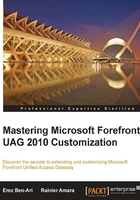
What this book covers
Chapter 1, Customization Building Blocks, discusses some of the operations of UAG in depth, and introduces the various technologies used as part of the customization process. It explains some key concepts that are required and lists other topics that will be required to perform such customizations properly. It also includes references to additional recommended reading.
Chapter 2, Customizing UAG's Look and Feel, will teach you how to perform various look and feel customizations, including text, languages, themes, images, JavaScript, and icons.
Chapter 3, Customizing Endpoint Detection and Policies, will guide you through the process of creating custom endpoint detection using VBScript and the UAG COM object model, as well as integrating the detection script with endpoint policies.
Chapter 4, The Application Wrapper and SRA, will explore how to take advantage of the Application Wrapper and SRA, which enable UAG to alter content on-the-fly. The chapter will also suggest how to use this mechanism to improve application compatibility and fix various content-parsing related issues.
Chapter 5, Creating Custom Application Templates, will discuss creating, editing, and customizing the default SSL-VPN templates, as well as creating new ones which can be used to let UAG run special scripts and commands on clients, and applications with special properties.
Chapter 6, Custom Certificate Authentication, will teach you how to create a custom authentication repository that can authenticate a user via a Smartcard or certificate.
Chapter 7, Custom Authentication Repositories, will go through creating custom authentication repositories that can interact with various types of authentication mechanisms that are not available with the built-in repositories.
Chapter 8, Extending the Login Process with Customization, will discuss the process of customizing the login and validation process, including extracting user and session information and manipulating it.
Chapter 9, Customizing Endpoint Components, will teach you how to configure the endpoint client components for customized distribution, making deployment easier.
Chapter 10, Additional Customizations, will discuss various other customizations that do not belong to the other classifications.